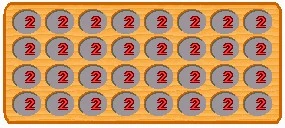| Choro |
| First Description: Jack Herbert Driberg, 1927 |
| Cycles: Two |
| Ranks: Four |
| Sowing: Multiple laps |
| Region: Uganda |
Choro is a mancala game played by the Acholi in northern Uganda and bordering Sudan. In 1991, they had a population of about 790,000. The game, which was first described by Jack Herbert Driberg (1888-1946) in 1927, is related to Omweso. It is played by both, men and women, but only among the same sex.
Rules
Choro requires a board of 32 holes (kul "cattle kraal") , arranged in four rows, each one with eight holes. A player controls one front row (cheng "sun") and one back row (dyewor "darkness"). In addition, 64 undifferentiated seeds ("dyang "cow" - plural idem) are needed.
Initial Position
First turn
The first turn of either player is played simultaneously. In contrast to the Langi variant of Choro a game can start with any hole. After that Choro is played turnwise.
Sowing
To play a move a player empties one of his holes, which contains at least two seeds, and distributes its contents, one by one, counterclockwise into the ensuing holes around his two rows.
If the last seed falls into an occupied hole, its contents are lifted for another lap.
The move ends, if the last seed falls into an empty hole.
Capturing
In contrast to the other Choro played by the Langi, it is never mandatory to make a move, which captures. Captures are always preceded by at least one lap.
General rules
If a lap ends in an occupied hole of the front row and both, the opponent's inner and outer row hole opposite, are also occupied, the contents of these two are captured.
- In the first turn only, that which is played simultaneously, a lap ending in an occupied hole of the player's back row also captures.
The captures are sown, one by one, in a counterclockwise direction into ensuing holes. The first seed must be placed into the hole, where the first seed of the last lap was dropped.
Capturing from the player's turn base
Similar to the game of Omweso, a capture can also be effected by reversing the direction of sowing by starting a lap from the player's turning base (alok "turning"). The leftmost hole of the back row is called wich ("head") and the penultimate hole on the left side of the front row pyer ("loin").
Reverse holes. White for South, Black for North
That is, instead of sowing in a counterclockwise direction, a player may sow clockwise from any of the two holes shown above if this results in a capture.
When the player captured from the first lap by sowing clockwise, he may (a) sow these captures clockwise again, if that would take the contents of two more holes, or (b) he can sow them counterclockwise as usual, or (c) he can leave them in the hole of his turn base, where the lap began.
- If he left the captures without sowing them, he may capture from the other hole of his turn base by sowing clockwise and repeat this procedure, if possible. However, this is not mandatory.
- After the last clockwise capture thus performed, the player takes the contents of any of his holes containing two or more seeds and sows them clockwise again.
When the player captured in a later lap, he may reverse the direction of sowing only once. After that he must continue to sow counterclockwise until he has reached his turn base again, that is, after having sown a full circuit around his two rows.
End of the game
The game ends, when, at his turn, a player cannot move.
The game is won by the player who was able to move last.
See also
- Choro I, a related game played by the Langi
References
- Driberg, J. H.
- The Game of Choro or Pereauni. In: Man: The Journal of the Royal Anthropological Institute 1927 (114); 27: 168-172.
- Driberg, J. H.
- The Game of Choro or Pereauni. In: Man: The Journal of the Royal Anthropological Institute 1927 (127); 27: 186-189.
- Murray, H. J. R.
- A History of Board-Games Other Than Chess. Oxford University Press, Oxford (England) 1951, 216-217.
- Russ, L.
- The Complete Mancala Games Book: How to Play the Worlds Oldest Board Games. Marlowe & Company, New York (USA) 2000, 117.
Copyright
© Mancala World.
By: Ralf Gering.
Under the CC by-sa 2.5.

